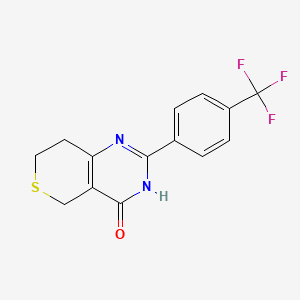Ferroptosis-centered Drug Response Information
General Information of the Drug (ID: ferrodrug0300)
| Name |
XAV939
|
||||
|---|---|---|---|---|---|
| Synonyms |
284028-89-3; XAV-939; XAV939; 3,5,7,8-Tetrahydro-2-[4-(trifluoromethyl)phenyl]-4H-thiopyrano[4,3-d]pyrimidin-4-one; XAV 939; 2-[4-(trifluoromethyl)phenyl]-1,5,7,8-tetrahydrothiopyrano[4,3-d]pyrimidin-4-one; CHEBI:62878; CHEMBL1086580; XAV-939 (GMP); CID 2726824; 2-(4-(trifluoromethyl)phenyl)-7,8-dihydro-5H-thiopyrano[4,3-d]pyrimidin-4-ol; 2-[4-(trifluoromethyl)phenyl]-7,8-dihydro-5H-thiino[4,3-d]pyrimidin-4-ol; 2-[4-(Trifluoromethyl)phenyl]-7,8-Dihydro-5h-Thiopyrano[4,3-D]pyrimidin-4-Ol; NVP-XAV-939; 2-(4-(trifluoromethyl)phenyl)-7,8-dihydro-3H-thiopyrano[4,3-d]pyrimidin-4(5H)-one; C14H11F3N2OS; XAV; MFCD16879017; 3kr8; 3uh4; Maybridge3_005018; NVP-XAV939; MLS006012021; SCHEMBL7783488; TB3748-GMP; SCHEMBL15315468; DTXSID60369423; XAV939,XAV-939; BCPP000009; HMS1445E02; HMS3414D07; HMS3648B17; HMS3654O16; HMS3678D07; HMS3743E05; BCP02128; EX-A1760; BDBM50188594; BDBM50318567; HB0660; HY-15147G; NSC755761; s1180; 2-[4-(trifluoromethyl)phenyl]-5H,7H,8H-thiopyrano[4,3-d]pyrimidin-4-ol; AKOS015954858; AKOS024457786; AKOS026750243; CCG-208105; CS-0494; NSC-755761; SB19432; IDI1_016405; NCGC00250397-01; NCGC00484998-01; AC-28393; CS-10386; HY-15147; SMR003874205; XAV939, >=98% (HPLC); CS-0615627; FT-0675873; SW218311-2; X0077; A25698; EN300-6732792; SR-01000946403; J-511234; SR-01000946403-1; BRD-K12762134-001-01-3; BRD-K12762134-001-05-4; Q27132250; Z2235801832; 2-(4-(Trifluoromethyl)phenyl)-3,5,7,8-tetrahydro-4H-thiopyrano[4,3-d]pyrimidin-4-one; 2-(4-(trifluoromethyl)phenyl)-7,8-dihydro-1H-thiopyrano[4,3-d]pyrimidin-4(5H)-one; 2-(4-(Trifluoromethyl)phenyl)-7,8-dihydro-5H-thiopyrano-[4,3-d]pyrimidin-4-ol; 2-[4-(trifluoromethyl)phenyl]-1H,4H,5H,7H,8H-thiopyrano[4,3-d]pyrimidin-4-one; 4H-Thiopyrano[4,3-d]pyrimidin-4-one, 3,5,7,8-tetrahydro-2-[4-(trifluoromethyl)phenyl]-?
Click to Show/Hide
|
||||
| Status |
Preclinical
|
||||
| Drug Type |
Small molecular drug
|
||||
| Structure |
 |
||||
| Formula |
C14H11F3N2OS
|
||||
| IUPAC Name |
2-[4-(trifluoromethyl)phenyl]-3,5,7,8-tetrahydrothiopyrano[4,3-d]pyrimidin-4-one
|
||||
| Canonical SMILES |
C1CSCC2=C1N=C(NC2=O)C3=CC=C(C=C3)C(F)(F)F
|
||||
| InChI |
InChI=1S/C14H11F3N2OS/c15-14(16,17)9-3-1-8(2-4-9)12-18-11-5-6-21-7-10(11)13(20)19-12/h1-4H,5-7H2,(H,18,19,20)
|
||||
| InChIKey |
KLGQSVMIPOVQAX-UHFFFAOYSA-N
|
||||
| PubChem CID | |||||
Full List of Ferroptosis Target Related to This Drug
Unspecific Target
| In total 3 item(s) under this Target | ||||
| Experiment 1 Reporting the Ferroptosis-centered Drug Act on This Target | [1] | |||
| Responsed Disease | Lung cancer | ICD-11: 2C25 | ||
| Responsed Regulator | Transcription factor SOX-4 (SOX4) | Suppressor | ||
| Pathway Response | Ferroptosis | hsa04216 | ||
| Apoptosis | hsa04210 | |||
| Cell Process | Cell ferroptosis | |||
| Cell proliferation | ||||
| Cell apoptosis | ||||
| In Vitro Model | NCI-H1299 cells | Lung large cell carcinoma | Homo sapiens | CVCL_0060 |
| Response regulation | The downregulation of the lncRNA MIR503HG induced by XAV939 may serve an important role in suppressing the progression of non-small cell lung cancer via sponging miR1273c, to downregulate its target SOX4. Furthermore, the downregulation of SLC7A11 induced by XAV939 may inhibit NSCLC development via participation in the ferroptosis pathway. | |||
| Experiment 2 Reporting the Ferroptosis-centered Drug Act on This Target | [1] | |||
| Responsed Disease | Lung cancer | ICD-11: 2C25 | ||
| Responsed Regulator | hsa-miR-1273c (miRNA) | Driver | ||
| Pathway Response | Ferroptosis | hsa04216 | ||
| Apoptosis | hsa04210 | |||
| Cell Process | Cell ferroptosis | |||
| Cell proliferation | ||||
| Cell apoptosis | ||||
| In Vitro Model | NCI-H1299 cells | Lung large cell carcinoma | Homo sapiens | CVCL_0060 |
| Response regulation | The downregulation of the lncRNA MIR503HG induced by XAV939 may serve an important role in suppressing the progression of non-small cell lung cancer via sponging miR1273c, to downregulate its target SOX4. Furthermore, the downregulation of SLC7A11 induced by XAV939 may inhibit NSCLC development via participation in the ferroptosis pathway. | |||
| Experiment 3 Reporting the Ferroptosis-centered Drug Act on This Target | [1] | |||
| Responsed Disease | Lung cancer | ICD-11: 2C25 | ||
| Responsed Regulator | MIR503HG (IncRNA) | Suppressor | ||
| Pathway Response | Ferroptosis | hsa04216 | ||
| Apoptosis | hsa04210 | |||
| Cell Process | Cell ferroptosis | |||
| Cell proliferation | ||||
| Cell apoptosis | ||||
| In Vitro Model | NCI-H1299 cells | Lung large cell carcinoma | Homo sapiens | CVCL_0060 |
| Response regulation | The downregulation of the lncRNA MIR503HG induced by XAV939 may serve an important role in suppressing the progression of non-small cell lung cancer via sponging miR1273c, to downregulate its target SOX4. Furthermore, the downregulation of SLC7A11 induced by XAV939 may inhibit NSCLC development via participation in the ferroptosis pathway. | |||
Cystine/glutamate transporter (SLC7A11)
| In total 1 item(s) under this Target | ||||
| Experiment 1 Reporting the Ferroptosis-centered Drug Act on This Target | [1] | |||
| Target for Ferroptosis | Suppressor | |||
| Responsed Disease | Lung cancer | ICD-11: 2C25 | ||
| Pathway Response | Ferroptosis | hsa04216 | ||
| Apoptosis | hsa04210 | |||
| Cell Process | Cell ferroptosis | |||
| Cell proliferation | ||||
| Cell apoptosis | ||||
| In Vitro Model | NCI-H1299 cells | Lung large cell carcinoma | Homo sapiens | CVCL_0060 |
| Response regulation | The downregulation of the lncRNA MIR503HG induced by XAV939 may serve an important role in suppressing the progression of non-small cell lung cancer via sponging miR1273c, to downregulate its target SOX4. Furthermore, the downregulation of SLC7A11 induced by XAV939 may inhibit NSCLC development via participation in the ferroptosis pathway. | |||
